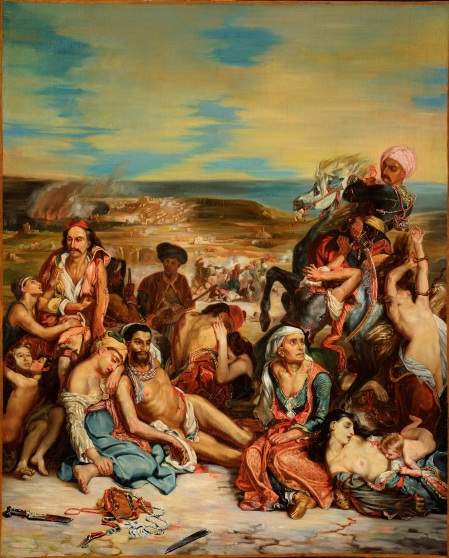
Eugène Delacroix
French, 1798-1863
The Massacre at Chios, reduced copy, 1842 ca.
Oil on canvas
39 5/8 x 31 7/8"
Musée du Vieux-Toulouse, Toulouse
inv. 33.2.3
COMMENTS
The year 1824 was crucial for French painting. Géricault died (after a riding accident); Ingres returned to France from Italy, and had his first public success; the first showing in Paris of works by the English Romantic painter John Constable was a revelation to many French artists; and “The Massacre at Chios” established Eugène Delacroix as the foremost New-Baroque Romantic painter. An admirer of both Gros and Géricault, Delacroix had been exhibiting for some years, but the “Massacre” - conservatives called it “the massacre of painting,” others acclaimed it enthusiastically - made his reputation. For the next quarter century, he and Ingres were acknowledge rivals, and their polarity, fostered by partisan critics, dominated the artistic scene in Paris.
Like “The Raft of ‘The Medusa," the "Massacre” was inspired by a contemporary event: the Greek war of independence against the Turks, which stirred a sympathetic response throughout Western Europe. Delacroix, however, aimed at “poetic truth” rather than at recapturing a specific, actual event. He shows us an intoxicating mixture of sensuousness and cruelty, but he does not succeed in forcing us to suspend our disbelief. While we revel in the sheer splendor of the painting, we do not quite accept the human experience as authentic. One reason may be the discontinuity of the foreground, with its dramatic contrasts of light and shade, and the luminous sweep of the landscape behind (Delacroix is said to have hastily repainted part of the latter after seeing Constable’s work). Originally, the background of “The Massacre” was probably like that in Géricault’s Mounted Officer; the Turkish horseman directly recalls Géricault’s earlier picture.
Delacroix’s sympathy with the Greeks did not prevent his sharing the enthusiasm of fellow Romantics for the Near East. He was enchanted by a visit to North Africa in 1832, finding there a living counterpart of the violent, chivalric, and picturesque past evoked in Romantic literature. His sketches from this trip supplied him with a large repertory of subjects for the rest of his life - harem interiors, street scenes, lion hunts. It is fascinating to compare his “Odalisque” with Ingres’ version: reclining in ecstatic repose, she exudes passionate abandon and animal vitality - the exact opposite of Ingres’ ideal.
H. W. Janson, History of Art, 4th Ed., Abrams, 1991, pp. 635-6
SBMA CURATORIAL LABELS
With the exhibition of this painting in 1824, Delacroix earned the critical recognition for which he yearned, as the leader of a new kind of painting, which would be dubbed Romanticism and seen as a clear departure from the reigning Neoclassical tradition. The subject, plucked from recent events, as opposed to ancient history, offered the pathetic spectacle of a people savagely decimated, first by insurgents from the island of Samos, and then by Turkish forces, reportedly reducing the native population of some 90,000 to just 900. Like the slightly older artists who he greatly admired, Théodore Géricault (1791-1824) and Antoine-Jean Gros (1771-1835), Delacroix produced countless studies in preparation for this monumental canvas. The deft synthesis of allusions to earlier works of art and studies done from life is in itself consistent with an academic working method. However, the asymmetry of the composition and the actual ambivalence of the subject as a pitiless representation of the horrors of war, along with the artist‘s unusual painterly technique made it a ringing statement for a bold new direction for modern art. This painting, while controversial, was largely admired for its daring. It was immediately purchased by the State. Its significance to the artist in later years is signaled by its inclusion in the selection of works he chose to exhibit in his retrospective at the Universal Exposition of 1855. He also had his students copy the painting, as a useful exercise and also, perhaps, as a means of facilitating its reproduction in a smaller-scaled print.
- Delacroix and the Matter of Finish, 2013
